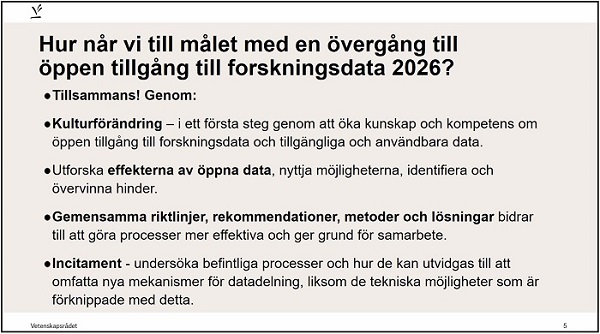
—Usefulness is created when data are used!
Sanja Halling from the Swedish Research Council couldn’t have made it clearer when she summarized what the work with open access to research data is all about, in the end. Together with representatives from three other Swedish research funding bodies, she took part in SND’s second webinar about the government’s goal to achieve open access to research data by 2026.
Since 2017, the Swedish Research Council has had a government mandate to facilitate and coordinate the Swedish work on introducing open access to research data. As part of this, they provide a comprehensive overview, analysis, and assessment of the national open access initiatives. There are many stakeholders that are central for the Swedish Research Council’s coordinating efforts, such as the higher education institutions, the National Library of Sweden, the National Archives, and the Agency for Digital Government (DIGG).
A need for more knowledge
—It’s important that we work together and in dialogue with one another, both on a national and international level. All parts of the eco-system have to be there if we want to achieve the goal, and we have to improve our knowledge of what open data means, and how to actually make data open. For that reason, we try to invite as many different stakeholders as possible to our reference and working groups, said Sanja Halling.
The other representatives from the research funding bodies further emphasized that a central factor in achieving the goal of open access to research data by 2026 is how to coordinate the different stakeholders.
—We follow the guidelines from the Swedish Research Council, as well as other national and national recommendations. It’s vital that we all work in the same way, across research domains. We don’t want to create parallel systems among different research funders, said Karla Anaya-Carlsson from Formas.
Eva Stensköld from Riksbankens jubileumsfond (RJ) highlighted that funders are reaching consensus on which guidelines that will apply for open access to research data, and remarked that infrastructures such as SND are important for maintaining a dialogue with the HEIs.
—We are a large funder, but with a small office, so we can’t be the driving force in this. But we’re happy to contribute to coordination and further guidelines, especially in legal matters, said Eva Stensköld.
She also stressed the importance of bidding the private research foundations welcome into these discussions.
—We are big players in this, and the work with open science can be done faster if we’re invited, too, so that we can take a broader perspective. We welcome the initiative from the Swedish Research Council to take a step ahead and intensify these efforts, she said.
Resuming an old tradition
Olle Lundberg from Forte said that even though their work with open science is based on the national and international initiatives, their focus has so far mainly been on open access to publications with scientific results. But their plan is to expand their work with open research data.
—There's a long tradition of openness in terms of research data. Back in the 1980s, we were many researchers who shared research and analysis materials with each other, so what we’re talking about now is, in a way, to resume this, but on a larger scale, said Olle Lundberg.
Lundberg stressed that we need to remember that there is a significant difference between making publications and research data openly accessible:
—There are so many more, and more complex, restrictions on data. Legislation is tougher, there are ethical guidelines, and we may be dealing with sensitive data, such as personal data. At the same time, the main arguments for openness are important: we need to be able to control data and results, and to reuse collected data.
Which research data should be accessible?
A central question that SND moderator Gustav Nilssone raised in the discussion was which research data should be accessible.
Sanja Halling and Karla Anaya-Carlsson remarked that the emphasis in the government proposition is on research data that are publicly funded and that form a basis for scientific publications. Current legislation must always be followed when data are made accessible. In the recommendations from the Swedish Research Council, they clearly state that publication shall meet the FAIR data principles, meaning that data should be findable, accessible, interoperable, and reusable.

—In cases where there are limitations to publishing research data, focus should be on making the metadata accessible, so that you can find information about existing data, said Sanja Halling.
Karla Anaya-Carlsson gave some examples on when open access to data would be helpful in Formas’s work with the UN Sustainable Development Goals:
—We have a group at Formas who work with systematic research compilations, and they review thousands of scientific articles to present recommendations for environmental actions and policies. When data aren’t openly accessible, it can be difficult to assess what’s correct and which recommendations to give.
Olle Lundberg reiterated that for many researchers it’s natural to share data and to publish program code, data matrices, and other materials:
—These are important questions that concern our scientific discussions and methods. We want to get feedback and communicate our research. Openness is in line with what we do in, for example, scientific seminars.
Mandatory data management plans
One tool that research funders and other stakeholders are using to facilitate open access to data is data management plans (DMP). Several research funders require DMPs, and the Swedish Research Council and SUHF have developed a template for data management plans. Sanja Halling emphasised that the Swedish Research Council regards data management plans as an important step to achieving accessible and usable data:
—Structure and order are the be all and end all for usability. Data management must be a part of the research process as early on as possible, and the DMP is intended as a support for researchers, rather than a burden. Our goal is to make the plan helpful to more efficient planning of, for instance, questions regarding open access to research data.
Karla Anaya-Carlsson also drew attention to the pedagogical usefulness of data management plans:
—A DMP is supposed to provide support and guidance for what we call “good data management”. It’s also a way to improve researchers’ knowledge and competence about how they should think about making data accessible.
Eva Stensköld mentioned that RJ have good experiences from data management plans in their contributions to the support form RJ Infrastructure for research. They may eventually require data management plans from those who are granted project funding.
—We who have collected the plans can see that they are good tools to assess how well the projects will manage their data. We need some carrots and sticks here. We never cut the researchers’ own budgets when they apply for grants for costs that we approve. If they can show that they have costs for open data and data management in the project, we will grant funding for that. We simply pay extra for what’s needed, said Eva Stensköld.
Olle Lundberg took a somewhat different approach and would like to think of the DMP as a continuation of the project plan.
—We can use the DMP to start off a process around open data, and not because it should be assessed in any way. We can’t let it become something big and heavy, but what's important is to make researchers aware of these questions.
Read more about how the research funders work with open science:
Swedish Research Council
Formas
Forte
Riksbankens jubileumsfond
